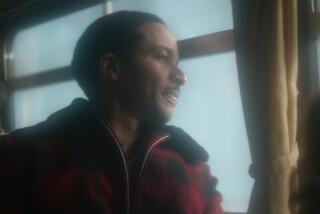Movie review: ‘The Artist’ a love note to the movies
- Share via
“The Artist” is the wonder of the age, as much a miracle as “Avatar,” though it comes at things from the totally opposite direction.
Far from embracing the most modern cinematic techniques, “The Artist” is a glorious throwback, a black-and-white silent movie that manages the impossible: It strikes an exact balance between the traditions of the past and the demands of the present, managing to be true to the look and spirit of bygone times while creating the most modern kind of witty and entertaining fun. Look on this work, ye mighty of Hollywood, and rejoice.
“The Artist” is no cynical pastiche, no glib and mocking reworking of old-fashioned tropes. It combines delightful humor and charm with what movies at their best have always conveyed: the honest power of pure emotion. It is a movie love story and a love note to the movies, all at the same time.
Perhaps the most surprising thing about this story of a successful Hollywood silent star confronting the coming of sound is that the creative team behind it is French. The film was shot by an American crew in historic Los Angeles locations with American costars such as John Goodman and James Cromwell and English language intertitles, but “The Artist” was conceived of and brought to life by French writer-director Michel Hazanavicius.
Best known in France for his pair of espionage spoofs, “OSS 117: Cairo, Nest of Spies” and “OSS 117: Lost in Rio,” Hazanavicius brought only cinematographer Guillaume Schiffman and his two stars, Jean Dujardin and Bérénice Bejo, with him on his Hollywood adventure.
A director with a deep understanding of silent cinema who talks knowledgeably about F.W. Murnau, King Vidor and Frank Borzage, Hazanavicius had wanted to make a project like this for years. “A silent film is a very special experience,” he said in Cannes, where Dujardin went on to win the best actor award. “It is not intellectual, it’s emotional. You take it in the way you take in music. There are times when language reduces communication, when you feel you are losing something when you start talking.”
Key to the success of “The Artist” is the work of its two French stars. Dujardin and Bejo, bursting off the screen like irrepressible Roman candles, give performances that are both subtle and incandescent, reminding us of the truth of silent star Norma Desmond’s famous “Sunset Blvd.” line, “We didn’t need dialogue. We had faces.”
It is the face of star George Valentin we see first, defying the villains that are torturing him in “A Russian Affair” and insisting, “I won’t talk, I won’t say a word.” Soon enough, our hero manages to escape with the aid of his trusty dog and declaims, “Long live free Georgia!” as he flies off to freedom.
That film within a film is playing to two audiences: the people in the theater at its 1927 premiere and George himself, watching from the wings with studio boss Al Zimmer (Goodman) and as entranced with himself as any fan. So much so that he is barely willing to introduce costar Constance (Missi Pyle) when the film is over.
As played by Dujardin, George is definitely the Ham What Am, but in the sweetest possible way. Inspired by athletic silent star Douglas Fairbanks, George has a brio and a complete beaming joy in performance that is infectious and inescapable. Plus, he has a rapport with his Jack Russell terrier sidekick that is the stuff of legend.
Stopping outside the theater to sign autographs for his mobs of adoring fans, George quite literally bumps into one of them, an energetic young woman appropriately named Peppy Miller (Bejo). It’s a classic meet-cute that finds its way onto the front page of the next day’s Variety with a headline wondering, “Who’s That Girl?”
That girl, as it turns out, is a dancer and aspiring actor who gets cast as an extra in George’s next picture, “A German Affair.” (So much for silent film originality). The two keep bumping into each other on set — Bejo has a brilliant moment doing a pantomime with the star’s empty suit jacket — but it seems fated to end there. George, as a delightful homage to the breakfast montage in “Citizen Kane” illustrates, is very much married to Doris (Penelope Ann Miller) and always under the watchful eye of chauffeur and man of all work Clifton (Cromwell).
The cheerful Peppy keeps getting bigger parts, and then comes 1929 and the game changer. Zimmer calls George into his office and shows him a test for sound pictures. “That’s the future,” the studio chief says. “If that’s the future,” his star responds, “you can keep it.”
While actors like Peppy embrace sound, George resists it. “I’m not a puppet, I’m an artist,” he insists. His predicament, and how Peppy comes to figure in it, is the heart of what makes “The Artist” so memorable.
With its echoes of everything from “A Star Is Born” to “Singin’ in the Rain,” “The Artist” is right at home in its numerous Los Angeles locations, which include Mary Pickford’s house on Fremont Place, the Bradbury Building, the back lots at Paramount and Warner Bros. and the circa 1915 Red Studios on Cahuenga Boulevard in the heart of old Hollywood. It revives a lost art and makes it live for today, and that is definitely something to be thankful for.
More to Read
The biggest entertainment stories
Get our big stories about Hollywood, film, television, music, arts, culture and more right in your inbox as soon as they publish.
You may occasionally receive promotional content from the Los Angeles Times.










